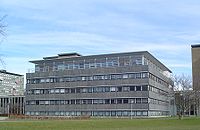
Hans Christian Ørsted Institute
Encyclopedia

University of Copenhagen
The University of Copenhagen is the oldest and largest university and research institution in Denmark. Founded in 1479, it has more than 37,000 students, the majority of whom are female , and more than 7,000 employees. The university has several campuses located in and around Copenhagen, with the...
is a building complex that houses the departments of Mathematics
University of Copenhagen Institute for Mathematical Sciences
The Department of Mathematical Sciences is an institute under the Faculty of Science at the University of Copenhagen.The department is located in the E building of the Hans Christian Ørsted Institute, on Universitetsparken 5 in Copenhagen, Denmark....
and Chemistry
University of Copenhagen Department of Chemistry
Research and education in chemistry has been conducted at the University of Copenhagen Department of Chemistry since 1778, when the first Laboratorium Chymicum was established. Since then, the chemists have moved several times, usually to better surroundings. In 1962, Universitetets Kemiske...
, as well as part of Physics. It is named after the physicist Hans Christian Ørsted
Hans Christian Ørsted
Hans Christian Ørsted was a Danish physicist and chemist who discovered that electric currents create magnetic fields, an important aspect of electromagnetism...
(1777–1851), who discovered electromagnetism
Electromagnetism
Electromagnetism is one of the four fundamental interactions in nature. The other three are the strong interaction, the weak interaction and gravitation...
(1820) and was the first to isolate aluminium
Aluminium
Aluminium or aluminum is a silvery white member of the boron group of chemical elements. It has the symbol Al, and its atomic number is 13. It is not soluble in water under normal circumstances....
(1825). By students and staff the institute is commonly called simply "HCØ".
The complex is made up of five connected buildings: A, B, C, D and E.
Building A is a long connecting building, it has ground, first floor and basement level and holds the auditoria.
Building B is a five floor building, and holds facilities for inorganic
Inorganic chemistry
Inorganic chemistry is the branch of chemistry concerned with the properties and behavior of inorganic compounds. This field covers all chemical compounds except the myriad organic compounds , which are the subjects of organic chemistry...
(ground, first and second level) and organic chemistry
Organic chemistry
Organic chemistry is a subdiscipline within chemistry involving the scientific study of the structure, properties, composition, reactions, and preparation of carbon-based compounds, hydrocarbons, and their derivatives...
(3rd, fourth and fifth level). In the basement of the building is a mass spectrometry
Mass spectrometry
Mass spectrometry is an analytical technique that measures the mass-to-charge ratio of charged particles.It is used for determining masses of particles, for determining the elemental composition of a sample or molecule, and for elucidating the chemical structures of molecules, such as peptides and...
apparatus.
Building C is a five floor building similar to building B and holds the sections for theoretical chemistry and spectroscopy
Spectroscopy
Spectroscopy is the study of the interaction between matter and radiated energy. Historically, spectroscopy originated through the study of visible light dispersed according to its wavelength, e.g., by a prism. Later the concept was expanded greatly to comprise any interaction with radiative...
.
Building D is a five floor building similar to B and C, but this is dedicated to physics and is as such part of the Niels Bohr Institute. It holds the Ørsted Laboratory.
Building E is another type building, not as large as the other three. It holds the mathematical section
University of Copenhagen Institute for Mathematical Sciences
The Department of Mathematical Sciences is an institute under the Faculty of Science at the University of Copenhagen.The department is located in the E building of the Hans Christian Ørsted Institute, on Universitetsparken 5 in Copenhagen, Denmark....
.

